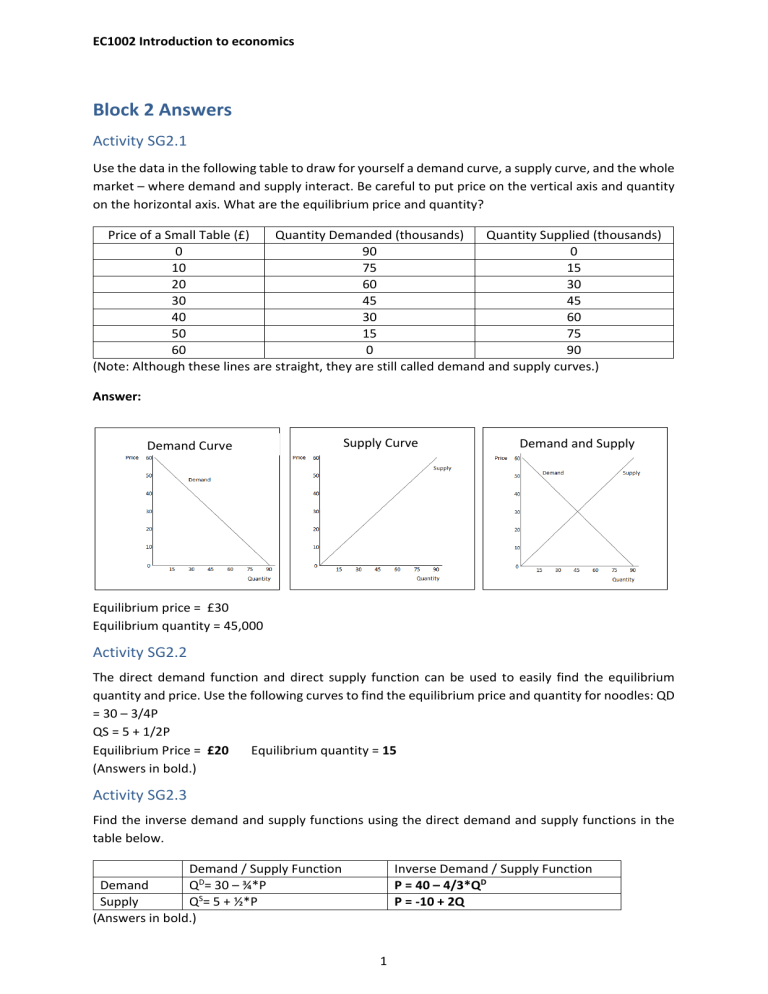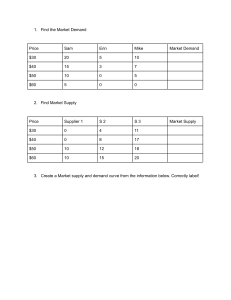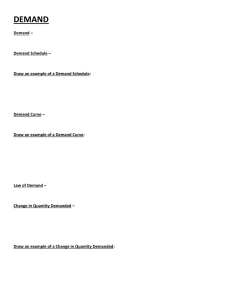Economics Study Guide Answers: Demand, Supply, Equilibrium
advertisement

EC1002 Introduction to economics Block 2 Answers Activity SG2.1 Use the data in the following table to draw for yourself a demand curve, a supply curve, and the whole market – where demand and supply interact. Be careful to put price on the vertical axis and quantity on the horizontal axis. What are the equilibrium price and quantity? Quantity Demanded (thousands) Quantity Supplied (thousands) Price of a Small Table (£) 0 90 0 10 75 15 20 60 30 30 45 45 40 30 60 50 15 75 60 0 90 (Note: Although these lines are straight, they are still called demand and supply curves.) Answer: Demand Curve Supply Curve Demand and Supply Equilibrium price = £30 Equilibrium quantity = 45,000 Activity SG2.2 The direct demand function and direct supply function can be used to easily find the equilibrium quantity and price. Use the following curves to find the equilibrium price and quantity for noodles: QD = 30 – 3/4P QS = 5 + 1/2P Equilibrium Price = £20 Equilibrium quantity = 15 (Answers in bold.) Activity SG2.3 Find the inverse demand and supply functions using the direct demand and supply functions in the table below. Demand / Supply Function Demand QD= 30 – ¾*P Supply QS= 5 + ½*P (Answers in bold.) Inverse Demand / Supply Function P = 40 – 4/3*QD P = ‐10 + 2Q 1 EC1002 Introduction to economics and make a graph of these in the following box: Supply and Demand Activity SG2.4 For each event in the following table, identify whether this relates to demand or supply, in what direction the curve would shift, and the effect on price and quantity. If you draw a graph for each example, you will also see the movement along the other curve, resulting in the new equilibrium price and quantity. The first line has been completed for you. The market for sushi Event The price of salmon increases Sushi becomes more popular in Europe The price of similar alternatives rises Sushi sellers expect the price of sushi to rise in the future New evidence reveals sushi is not as healthy people had thought New machines are invented which make sushi production more efficient (Answers in bold.) Which curve shifts? Supply or demand? Supply Direction? Effect on price? Effect on quantity? Left Higher Lower Movement along the other curve – which direction? Demand, left Demand right higher higher Supply, right Demand right higher higher Supply, right Supply left higher lower Demand, left Demand left lower lower Supply, left Supply right lower higher Demand, right 2 EC1002 Introduction to economics Activity SG2.5 Multiple choice questions 1. The only four consumers in a market have the following willingness to pay for a good: Buyer Willingness to pay Sally £15 Simon £25 Susan £35 Shaun £45 If there is only one unit of the good and if the buyers bid against each other for the right to purchase it, then the consumer surplus will be a) £0 or slightly less b) £10 or slightly less c) £30 or slightly less d) £45 or slightly less. NB: It may help to calculate the price first. Assume it is an open auction where each bidder calls the price out aloud. Answer: (b) £10 or slightly less. (Explanation: The price is set in an open auction where the bidder calls the price aloud. Although Shaun is willing to pay of £45, once the other consumers have revealed their willingness to pay, Shaun must only make a bid of just over £35 to be the highest bidder and get the item. The consumer surplus is the difference between the price he pays (just over £35) and his willingness to pay (£45).) 2. Examine the diagram below: £120 Supply Curve £100 £80 £60 Equilibrium £40 Demand Curve £20 0 100 Quantity Figure 2.1 3 EC1002 Introduction to economics At the equilibrium price, the producer surplus is equal to: e) a. £2,000 f) b. £4,000 g) c. £6,000 h) d. £10,000. Answer: (a) £2,000. (Explanation: (60 – 20)*100*1/2 = 2000.) 3. Here you see Anthony’s demand curve for football matches (you can treat the demand curve as being approximately linear). P £8 £6 0 6 Q 10 Figure 2.2 When the price per match falls from £8 to £6, his welfare: i) Rises by £16 j) Falls by £16 k) Rises by £12 l) Falls by £12. Answer: (a) Rises by £16. (Explanation: Calculating the change in welfare (consumer surplus) involves finding the sum of the areas of rectangle A and triangle B: A = (8 – 6) x (6 – 0) = 12; B = [(8 – 6) x (10 – 6)]/2 = 4. Hence, A+B = 16.) 4 EC1002 Introduction to economics Activity SG2.6 Price floors and ceilings result in a loss of consumer and producer surplus, this is called a deadweight loss. Can you calculate how much consumer and producer surplus is lost due to the price ceiling in the diagram below? Has there also been a transfer of surplus between consumers and producers? Loss of Producer and Consumer Surplus due to a Price Ceiling Price £120 £100 Supply Curve £80 Free Market Equilibrium £60 Price Ceiling £40 Excess demand Demand Curve £20 0 50 100 Quantity Figure 2.3 Answer: Initial consumer surplus: Initial producer surplus: Initial total surplus = Consumer surplus with price ceiling: Producer surplus with price ceiling: Total surplus with price ceiling: Deadweight loss: Transfer of surplus from producers to consumers: 5 2000 2000 4000 2500 500 3000 1000 500 EC1002 Introduction to economics Sample examination questions Multiple choice questions For each question, choose the correct response: 1. An increase in consumer incomes would result in a) a decrease in demand for bread b) a decrease in demand for diamonds c) a decrease in demand for low‐quality cars d) an increase in demand for inter‐city bus travel (compared to flying or taking the train). 2. An increase in the price of chilli would lead to a) an increase in demand for Mexican food b) a decrease in supply of Mexican food c) an increase in the supply of Mexican food d) a decrease in demand for other spices. 3. From the diagram below, the loss in consumer surplus due to the price floor is: a) £50 b) £100 c) £150 d) £200. Price £50 Supply Curve Excess supply £40 Price Floor £30 Free Market Equilibrium £20 Demand Curve £10 0 10 20 30 Quantity Figure 2.4 4. Given the following inverse demand and supply curves: P = 8 – QD/2 P = 2 + QS 6 EC1002 Introduction to economics and assuming that price is fixed below the equilibrium price at £5, the loss in producer surplus due to the price ceiling is: 5. a) £3.50 b) £4.50 c) £8 d) £9. The demand curve for good A is given by Q AD = a – bPA + cPB a) Goods A and B are complements. b) Goods A and B are substitutes. c) Goods A and B are unrelated in consumption. d) The demand curve for good A is upward sloping. 6. The demand curve for good A is given by Q AD = a – bPA + cPB a) The quantity of A purchased falls and the price of A falls. b) The quantity of A purchased increases and the price of A increases. c) The quantity of A purchased increases and the price of A falls. d) The quantity of A purchased increases and the price of A stays the same. 7. Suppose that the price of Porto wine was £20 per litre in 2010 and £25 per litre in 2011. Ingrid observes that Margaret’s consumption of wine rose from 1 litre per month in 2010 to 1.2 litres per month in 2011. Ingrid concludes that Margaret’s demand for Porto wine has to be upward sloping: a) Ingrid is wrong: given the above information Margaret’s demand for Porto wine has to be downward sloping. b) Ingrid is right: given the above information Margaret’s demand for Porto wine has to be upward sloping. c) Ingrid is wrong: the above information is not enough to conclude that Margaret’s demand for Porto is necessarily upward sloping. Answers: 1. 2. 3. 4. 5. 6. 7. c. A decrease in demand for low‐quality cars b. A decrease in supply of Mexican food b. £100 a. £3.50 b. Goods A and B are substitutes b. The quantity of A purchased increases and the price of A increases. c. There is not enough information to answer this question. 7 EC1002 Introduction to economics Long answer question Suppose that the inverse demand and supply schedules for rental apartments in the city of Auckland are as given by the following equations: Demand: P = 2700 – 0.12QD Supply: P = ‐300 + 0.12QS a) What is the market equilibrium rental price per month and the market equilibrium number of apartments demanded and supplied? Answer: $1,200 ; 12,500 apartments b) If the local government can enforce a rent‐control law that sets the maximum monthly rent at $900, will there be a surplus or a shortage? Of how many units will this be? And how many units will actually be rented each month? Answer: Shortage of 5000 apartments, 10,000 units actually rented c) Suppose that the government decides to implement a policy to keep out the poor. It declares that the minimum rent that can be charged is $1500 per month. If the government can enforce that price floor, will there be a surplus or a shortage? Of how many units will this be? And how many units will actually be rented each month? Answer: There will be a surplus of 5000 apartments; 10,000 apartments will actually be rented. d) Suppose that the government wishes to decrease the market equilibrium monthly rent to $900 by increasing the supply of housing. Assuming that demand remains unchanged, find the new equilibrium quantity and the new inverse supply curve. Answer: 15,000 apartments; P = ‐900 + 0.12Qs’ 8







